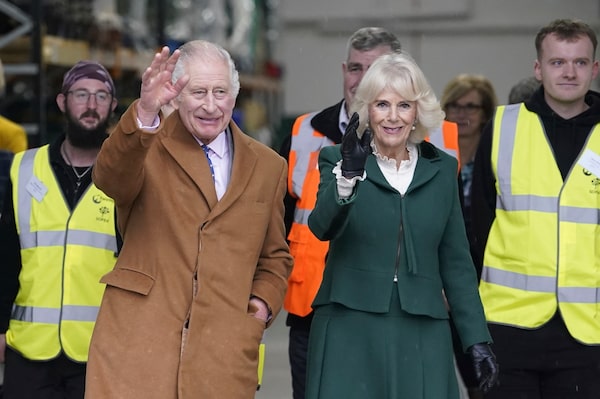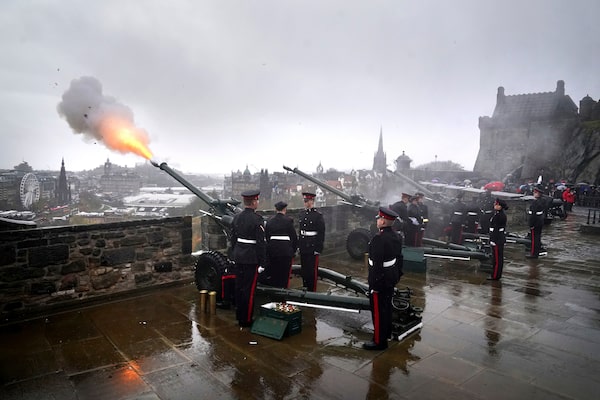
King Charles and Queen Camilla arrive to mark the King's 75th birthday at the official launch of The Coronation Food Project, at the South Oxfordshire Food and Education Alliance surplus food distribution centre, in Didcot, Oxfordshire, England, Nov. 14.Andrew Matthews/The Associated Press
At an age when many of his contemporaries have long since retired, King Charles III is not one to put his feet up.
The king will mark his 75th birthday on Tuesday by busily highlighting causes close to his heart.
With Queen Camilla at his side, Charles will visit a project that helps feed those in need by redistributing food that might otherwise go to landfills. Then he’ll host a party for 400 nurses and midwives, saluting the National Health Service’s own 75th birthday. For good measure, the king appears on the cover of this month’s Big Issue, which gives marginalized people the opportunity to earn money by selling the magazine on the street.
It’s the sort of day that’s been typical of the king’s first 14 months on the throne.
After the seven-decade reign of his late mother, Queen Elizabeth II, Charles has rushed to show that the monarchy remains relevant in modern British society. He’s made three overseas visits, pledged to open the royal archives to researchers investigating the crown’s links to slavery and expressed “sorrow and regret’’ for “abhorrent and unjustifiable acts of violence” committed against Kenyans during their struggle for independence.
Charles’s reign has gotten off to a steady start, but he still needs to set out a clear vision for the future, said Ed Owens, an historian and author of “After Elizabeth: Can the Monarchy Save Itself?’’
Royal Canadian Mint to begin producing coins bearing face of King Charles
“It’s a difficult moment for the monarchy because it’s going through this period of transition from being adulated as a default position to now being questioned and challenged in new ways,’’ Owens said. “And I just wish that the king and his heir would set out more clearly what they want to do rather than take for granted what they think the British public want from the monarchy.”
Charles’ long apprenticeship meant he was a grey-haired septuagenarian when he finally took the throne, fueling concerns he would have a hard time connecting with a country that no longer takes deference to the monarchy for granted.
But all those decades also gave him more training and experience to draw upon than his mother, who was just 25 when she became queen.
While Elizabeth, like all British monarchs before her, was educated by tutors, Charles was bundled off to Hill House School in London before his eighth birthday to begin experiencing the world outside the palace. The school prides itself on teaching children that they should learn to live with people of different nationalities, races and religions.

The 16 Regiment Royal Artillery fire a 21 Gun salute at Edinburgh Castle to mark the 75th birthday of King Charles, on Nov. 14.Andrew Milligan/The Associated Press
In another royal first, Charles earned a degree in history from the University of Cambridge. He later spent six years in the Royal Navy before leaving to focus on his duties as heir to the throne.
As Prince of Wales, the future king founded a charity that helps young people get jobs and training. He started an organic food company and dabbled in urban planning. He was also an early advocate for conservation and environmental protection – something that helps him appeal to his younger subjects.
But it is his heir, Prince William, who is now focused on the younger generation, seeking a leading role in the environmental movement with his Earthshot Prize, a global competition to find ways to combat climate change. He is also working on initiatives to fight homelessness and raise awareness of the importance of mental health.
While William may be easing the strain on his father, his younger brother has offered public challenges.
Over the past year Prince Harry released a Netflix series and a memoir that exposed rivalries within the royal family, criticized the palace’s relations with the media and said his wife, Meghan, was subjected to racism as a working member of the royal family.
All of that contributed to Harry and Meghan’s decision to give up royal duties and move to California three years ago, leaving the royal family without the glamorous young couple who were expected to help the monarchy reach out to younger people.
“What Harry and Meghan have also done is they provided us with another view onto this institution,” Owens said. “They’ve pulled back the curtain in terms of its inner workings and have revealed what is often a quite poisonous, toxic culture with these competing households.”
As he weathers these storms, Charles has his queen for support.
The biggest controversy of Charles’ life was the breakdown of his first marriage to the late Princess Diana amid stories about his longtime relationship with the woman who would become his second wife, Camilla Parker-Bowles.
Although Diana’s fans initially bridled at the idea of Camilla ever becoming queen, by the time the invitations for the coronation went out Charles had made his wishes clear: “The Coronation of Their Majesties King Charles III and Queen Camilla.’’